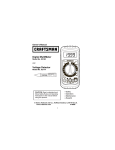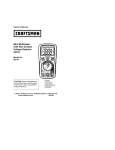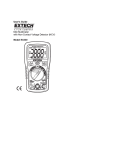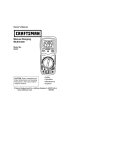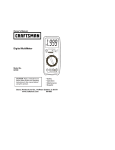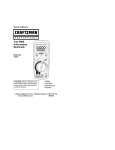Download Craftsman 82312 Owner`s manual
Transcript
Owner’s Manual Mini Multimeter with Non-Contact Voltage Detector (NCV) Model No. 82312 CAUTION: Read, understand and follow Safety Rules and Operating Instructions in this manual before using this product. ! Safety ! Operation ! Maintenance ! Español © Sears, Roebuck and Co., Hoffman Estates, IL 60179 U.S.A. www.craftsman.com 071006 TABLE OF CONTENTS Warranty............................................................................................ 3 Safety Instructions ............................................................................ 4 Safety Symbols ................................................................................. 5 Controls And Jacks........................................................................... 6 Symbols ............................................................................................ 7 Specifications .................................................................................... 8 Battery Installation .......................................................................... 11 Operating Instructions .................................................................... 12 Non-Contact AC Voltage Detector ............................................. 13 AC Voltage Measurements......................................................... 14 DC Voltage Measurements......................................................... 15 Battery Voltage Test ................................................................... 16 AC / DC Current Measurements................................................. 17 Resistance Measurements ......................................................... 18 Continuity Check ......................................................................... 19 Diode Test ................................................................................... 20 Maintenance ................................................................................... 21 Low Battery Indication .................................................................... 21 Battery Replacement ...................................................................... 22 Replacing The Fuses...................................................................... 22 Troubleshooting .............................................................................. 24 Service And Parts ........................................................................... 24 2 ONE YEAR FULL WARRANTY ONE YEAR FULL WARRANTY ON CRAFTSMAN MULTIMETER If this CRAFTSMAN Multimeter fails to give complete satisfaction within one year from the date of purchase, RETURN IT TO THE NEAREST SEARS STORE OR OTHER CRAFTSMAN OUTLET IN THE UNITED STATES, and Sears will replace it, free of charge. This warranty gives you specific legal rights, and you may also have other rights which vary from state to state. Sears, Roebuck and Co., Dept. 817WA, Hoffman Estates, IL 60179 For Customer Assistance Call 9am - 5pm (ET) Monday through Friday 1-888-326-1006 WARNING: USE EXTREME CAUTION IN THE USE OF THIS DEVICE. Improper use of this device can result in injury or death. Follow all safeguards suggested in this manual in addition to the normal safety precautions used in working with electrical circuits. DO NOT service this device if you are not qualified to do so. 3 SAFETY INSTRUCTIONS This meter has been designed for safe use, but must be operated with caution. The rules listed below must be carefully followed for safe operation. 1. NEVER apply voltage or current to the meter that exceeds the specified maximum: Input Protection Limits Function Maximum Input V DC or V AC 600V AC and DC mA AC/DC 200mA DC/AC A AC/DC 10A DC/AC (for 30 seconds max. every 15 minutes) Resistance, Diode Test, Continuity 250V DC/AC 2. 3. 4. 5. 6. 7. 8. USE EXTREME CAUTION when working with high voltages. DO NOT measure voltage if the voltage on the "COM" input jack exceeds 600V above earth ground. NEVER connect the meter leads across a voltage source while the function switch is in the current, resistance, or diode mode. Doing so can damage the meter. ALWAYS discharge filter capacitors in power supplies and disconnect the power when making resistance or diode tests. ALWAYS turn off power and disconnect test leads before opening the covers to replace the fuse or battery. NEVER operate the meter unless the back cover and the battery and fuse covers are in place and fastened securely. If the equipment is used in a manner not specified by the manufacturer, the protection provided by the equipment may be impaired. 4 SAFETY SYMBOLS This symbol adjacent to another symbol, terminal or operating device indicates that the operator must refer to an explanation in the Operating Instructions to avoid personal injury or damage to the meter. WARNING This WARNING symbol indicates a potentially hazardous situation, which if not avoided, could result in death or serious injury. CAUTION This CAUTION symbol indicates a potentially hazardous situation, which if not avoided, may result damage to the product. MAX 600V This symbol advises the user that the terminal(s) so marked must not be connected to a circuit point at which the voltage with respect to earth ground exceeds 600V. This symbol adjacent to one or more terminals identifies them as being associated with ranges that may, in normal use, be subjected to particularly hazardous voltages. For maximum safety, the meter and its test leads should not be handled when these terminals are energized. This symbol indicates that a device is protected throughout by double insulation or reinforced insulation. 5 CONTROLS AND JACKS 1. AC Voltage Detector Sensor 2. AC Voltage Detector indicator light 3. LCD display 4. Non-contact AC Voltage Detector test button 5. Rotary function dial 6. 10 ampere test lead jack 7. COM test lead jack 8. Test lead jack for voltage, milliamp, resistance/continuity, and diode functions 9. Protective rubber holster (must be removed to access the rear battery compartment) 6 SYMBOLS •))) Continuity Diode Battery status AC DC -3 m k V A ! milli (10 ) (volts, amps) 3 kilo (10 ) (ohms) Volts Amps Ohms AC DC Alternating current Direct current 7 SPECIFICATIONS Function Range Resolution Accuracy Non100 to Resolution & accuracy do not apply since contact AC 600V the meter does not display the voltage in Voltage this mode. The lamp at the top of the detector meter’s display flashes when voltage is sensed and an audible warning will sound. DC Voltage 200mV 0.1mV (V DC) !(0.5% reading + 2 digits) 2000m 1mV V 20V 0.01V 200V 0.1V 600V AC Voltage 200V (VAC) 600V 50/60Hz !(1.0% reading + 2 digits) 1V !(1.5% reading + 2 digits) 0.1V !(1.5% reading + 3 digits) 1V !(2.0% reading + 4 digits DC Current 200mA 0.1mA !(1.5% reading + 2 digits) (A DC) 0.01A !(2.5% reading + 5 digits) AC Current 200mA 0.1mA !(1.8% reading + 5 digits) (AAC) 50/60Hz 0.01A !(3.0% reading + 7 digits) 0.1! !(1.2% reading + 4 digits) 10A 10A Resistance 200! 2000! 1! 20k! 0.01k! 200k! 0.1k! !(1.2% reading + 2 digits) 2000k! 1k! 8 Notes: Accuracy specifications consist of two elements: • (% reading) – This is the accuracy of the measurement circuit. • (+ digits) – This is the accuracy of the analog to digital converter. o o o o Accuracy is stated at 65 F to 83 F (18 C to 28 C) and less than 75% RH. Diode Test Bias voltage: 2.3VDC Continuity Check Audible signal will sound if the resistance is less than 100! Input Impedance 10M! (VDC & VAC) AC Bandwidth 50 / 60Hz Display 2000 count (0 to 1999) LCD Overrange indication “1___” is displayed Polarity Automatic (no indication for positive); Minus (-) sign for negative Measurement Rate 2 times per second, nominal Low Battery Indication “ ” is displayed if battery voltage drops below operating voltage Battery One (1) 9V battery Fuses mA range; 200mA/250V fast blow A range; 10A/250V fast blow, ceramic Operating Temperature 32ºF to 122ºF (0ºC to 50ºC) o o o o Storage Temperature -4 F to 140 F (-20 C to 60 C) Operating Humidity Max 70% up to 87ºF (31ºC) decreasing linearly to 50% at 122ºF (50ºC) Storage Humidity < 80% RH Operating Altitude 7000 ft. (2000 meters) maximum. Weight 9.17 oz (260g) includes holster Size 5.8” x 2.9” x 1.6” (147 x 76 x 42mm) includes holster Approvals CE, UL 9 Safety UL LISTED This meter is intended for indoor use and protected, against the users, by double insulation per EN61010-1 and IEC61010-1 2nd Edition (2001) to CAT II 1000V & CAT III 600V; Pollution Degree 2. The meter also meets UL 61010-1, Second Edition (2004), CAN/CSA C22.2 No. 610101, Second Edition (2004), and UL 61010B-2-031, First Edition (2003) The UL mark does not indicate that this product has been evaluated for the accuracy of its readings. PER IEC1010 OVERVOLTAGE INSTALLATION CATEGORY OVERVOLTAGE CATEGORY I Equipment of OVERVOLTAGE CATEGORY I is equipment for connection to circuits in which measures are taken to limit the transient overvoltages to an appropriate low level. Note – Examples include protected electronic circuits. OVERVOLTAGE CATEGORY II Equipment of OVERVOLTAGE CATEGORY II is energyconsuming equipment to be supplied from the fixed installation. Note – Examples include household, office, and laboratory appliances. OVERVOLTAGE CATEGORY III Equipment of OVERVOLTAGE CATEGORY III is equipment in fixed installations. Note – Examples include switches in the fixed installation and some equipment for industrial use with permanent connection to the fixed installation. OVERVOLTAGE CATEGORY IV Equipment of OVERVOLTAGE CATEGORY IV is for use at the origin of the installation. Note – Examples include electricity meters and primary overcurrent protection equipment 10 BATTERY INSTALLATION WARNING: To avoid electric shock, disconnect the test leads from any source of voltage before removing the battery cover. 1. Disconnect the test leads from the meter. 2. Remove the rear battery cover by removing the two screws using a Phillips head screwdriver. 3. Insert the battery into battery clips, observing the correct polarity. 4. Put the battery cover back in place and secure with the two screws. WARNING: To avoid electric shock, do not operate the meter until the battery cover is in place and fastened securely. NOTE: If your meter does not work properly, check the fuses and batteries to make sure that they are still good and that they are properly inserted. 11 OPERATING INSTRUCTIONS WARNING: Risk of electrocution. High-voltage circuits, both AC and DC, are very dangerous and should be measured with great care. NOTE: On some low AC and DC voltage ranges, with the test leads not connected to a device, the display may show a random, changing reading. This is normal and is caused by the high-input sensitivity. The reading will stabilize and give a proper measurement when connected to a circuit. 12 NON-CONTACT AC VOLTAGE DETECTOR The EX310 can detect the presence of AC voltage (from 100 to 600VAC) simply by being held very near to a voltage source. WARNING: Test the AC voltage detector on a known live circuit before each use. WARNING: Before using the meter in the AC Voltage Detector mode, verify that the battery is fresh by confirming characters appear on the LCD when the function dial is turned to any position. Do not attempt to use the meter as an AC Voltage Detector if the battery is weak or bad. NON-CONTACT VOLTAGE (NCV) The NCV function works on any rotary switch position. 1. Test the detector on a known live circuit before use. 2. Press and hold the NCV button for the duration of the test. The meter will beep once when the button is pushed. 3. Hold the top of the meter very close to the voltage source as shown. 4. If voltage is present, the rim of the LCD display will flash a bright orange and an audible warning will sound. 13 AC VOLTAGE MEASUREMENTS WARNING: Risk of Electrocution. The probe tips may not be long enough to contact the live parts inside some 240V outlets for appliances because the contacts are recessed deep in the outlets. As a result, the reading may show 0 volts when the outlet actually has voltage on it. Make sure the probe tips are touching the metal contacts inside the outlet before assuming that no voltage is present. CAUTION: Do not measure AC voltages if a motor on the circuit is being switched ON or OFF. Large voltage surges may occur that can damage the meter. 1. 2. 3. 4. 5. Set the function switch to the 600 VAC position. Insert the black test lead banana plug into the negative COM jack. Insert red test lead banana plug into the positive V jack. Touch the black test probe tip to the neutral side of the circuit. Touch the red test probe tip to the “hot” side of circuit. Read the voltage in the display. 14 DC VOLTAGE MEASUREMENTS CAUTION: Do not measure DC voltages if a motor on the circuit is being switched ON or OFF. Large voltage surges may occur that can damage the meter. 1. 2. 3. 4. Set the function switch to the highest VDC position. Insert the black test lead banana plug into the negative COM jack. Insert the red test lead banana plug into the positive V jack. Touch the black test probe tip to the negative side of the circuit. Touch the red test probe tip to the positive side of the circuit. Read the voltage in the display. Move the function switch to successively lower VDC positions to obtain a higher resolution reading. 15 BATTERY VOLTAGE TEST CAUTION: Do not measure batteries while they are installed in the devices they are powering. The batteries must be removed from installations before tests can be made. 1. 2. 3. 4. Set the function switch to the 1.5V or 9V BAT switch position. Use the 1.5V position for ‘AAA’, ‘AA’, ‘C’, ‘D’, and other 1.5V batteries. Use the 9V position for square 9V transistor batteries. Insert the black test lead banana plug into the negative COM jack. Insert the red test lead banana plug into the positive V jack. Touch the black test probe tip to the negative side of the battery. Touch the red test probe tip to the positive side of the battery. Read the voltage in the display. 16 AC / DC CURRENT MEASUREMENTS CAUTION: Do not make current measurements at 10 Amps for longer than 30 seconds. Exceeding 30 seconds may cause damage to the meter and/or the test leads. 1. 2. 3. 4. 5. 6. 7. Insert the black test lead banana plug into the negative COM jack. For current measurements up to 200mA AC or DC, set the function switch to the 200m AAC or ADC position and insert the red test lead banana plug into the mA jack. For current measurements up to 10A AC or DC, set the function switch to the 10A AAC or 10A ADC position and insert the red test lead banana plug into the 10A jack. Remove power from the circuit under test, then open up the circuit at the point where you wish to measure current. Touch the black test probe tip to the negative side of the circuit. Touch the red test probe tip to the positive side of the circuit. Apply power to the circuit. Read the current in the display. 17 RESISTANCE MEASUREMENTS WARNING: To avoid electric shock, disconnect power to the unit under test and discharge all capacitors before taking any resistance measurements. 1. Set the function switch to the highest !! position. 2. Insert the black test lead banana plug into the negative COM jack. Insert the red test lead banana plug into the positive ! jack. Touch the test probe tips across the circuit or part under test. It is best to disconnect one side of the part under test so the rest of the circuit will not interfere with the resistance reading. Read the resistance in the display. Move the function switch to successively lower ! positions to obtain a higher resolution reading. 3. 4. 5. 18 CONTINUITY CHECK WARNING: To avoid electric shock, never measure continuity on circuits that have a voltage potential. 1. 2. 3. 4. 5. Set the function switch to the position. Insert the black lead banana plug into the negative COM jack. Insert the red test lead banana plug into the positive ! jack. Touch the test probe tips to the circuit or wire you wish to check. If the resistance is less than approximately 100!, the audible signal will sound. If the circuit is open, the display will indicate “1___”. 19 DIODE TEST 1. 2. 3. 4. 5. Set the function switch to the position. Insert the black test lead banana plug into the negative COM jack and the red test lead banana plug into the positive jack. Touch the test probes to the diode under test. A good diode will indicate approx. 700 ohms for the forward test and “1___” for the reverse test. A shorted diode will indicate the same value of resistance in both the reverse and forward test directions. An open diode will indicate “1___” in both test directions. 20 MAINTENANCE WARNING: To avoid electric shock, disconnect the test leads from any source of voltage before removing the back cover or the battery or fuse covers. WARNING: To avoid electric shock, do not operate your meter until the battery and fuse covers are in place and fastened securely. This MultiMeter is designed to provide years of dependable service, if the following care instructions are performed: 1. 2. 3. 4. 5. 6. KEEP THE METER DRY. If it gets wet, wipe it off. USE AND STORE THE METER IN NORMAL TEMPERATURES. Temperature extremes can shorten the life of the electronic parts and distort or melt plastic parts. HANDLE THE METER GENTLY AND CAREFULLY. Dropping it can damage the electronic parts or the case. KEEP THE METER CLEAN. Wipe the case occasionally with a damp cloth. DO NOT use chemicals, cleaning solvents, or detergents. USE ONLY FRESH BATTERIES OF THE RECOMMENDED SIZE AND TYPE. Remove old or weak batteries so they do not leak and damage the unit. IF THE METER IS TO BE STORED FOR A LONG PERIOD OF TIME, the battery should be removed to prevent damage to the unit. LOW BATTERY INDICATION WARNING: To avoid electric shock, disconnect the test leads from any source of voltage before removing the battery cover. Do not operate meter unless the battery is in place. LOW BATTERY INDICATION The icon will appear in the lower left-hand corner of the display when the battery voltage becomes low. Replace the batteries when this appears. 21 BATTERY REPLACEMENT 1. Disconnect the test leads from the meter. 2. Remove the protective rubber holster. See diagram. 3. Remove the Phillips head screw located on the lower back of the instrument. 4. Remove the fuse/battery compartment cover to access the battery. See diagram. 5. Replace the 9V battery observing polarity. 6. Secure the fuse/battery compartment cover using the Phillips head screw. 7. Place the protective rubber holster on the meter. 2 1 5 3 4 6 1. Removable Rubber Holster 2. Meter 3. Battery 4. Fuses 5. Compartment Cover 6. Rubber Holster 22 REPLACING THE FUSES WARNING: To avoid electric shock, disconnect the test leads from any source of voltage before removing the fuse cover. 1. Disconnect the test leads from the meter. 2. Remove the protective rubber holster. 3. Remove the Phillips head screw located on the lower back of the instrument. 4. Remove the fuse/battery compartment cover to access the fuses. 5. Gently remove the fuse(s) and install new fuse(s) into the holder(s). 6. Always use fuses of the proper size and value (200mA/250V fast blow for the mA / !A ranges, 10A/250V fast blow for the A range). 7. Secure the fuse/battery compartment cover. 8. Place the protective rubber holster on the meter. 2 1 5 3 4 6 WARNING: To avoid electric shock, do not operate your meter until the fuse cover is in place and fastened securely. 23 TROUBLESHOOTING There may be times when your meter does not operate properly. Here are some common problems that you may have and some easy solutions to them. Meter Does Not Operate: 1. Always read all the instructions in this manual before use. 2. Check to be sure the battery is properly installed. 3. Check to be sure the battery is good. 4. If the battery is good and the meter still doesn’t operate, check to be sure that both ends of the fuse are properly installed. If You Do Not Understand How the Meter Works: 1. Purchase “Multitesters and Their Use for Electrical Testing”, (Item No. 82303). 2. Call our Customer Service Line 1-888-326-1006. SERVICE AND PARTS Item Number Description 82374 93894 82312-L 82312-D 82312-C 82312-CS 82394 Fuse kit 9V battery Set of black and red Test Leads Replacement battery cover Front Cover Rear cover screws Thermocouple probe For replacement parts shipped directly to your home Call 9 am – 5 pm Eastern Time, M - F 1-888-326-1006 24
























